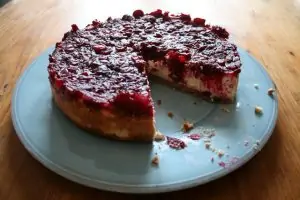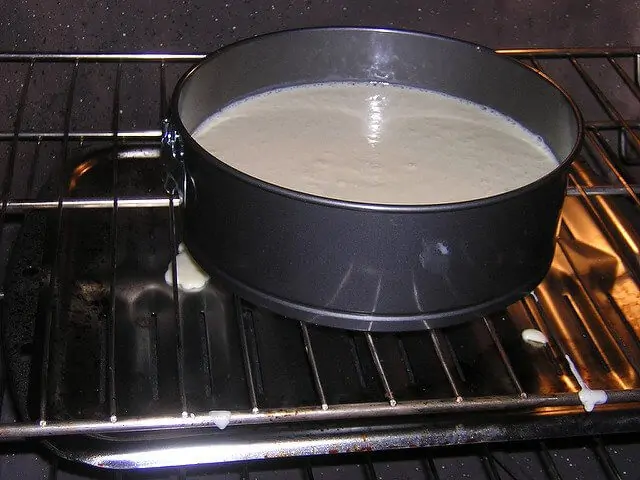
I don’t know a lot of people who don’t like cheesecake. In fact, I don’t know anyone immune to its siren call. Of course, people do have their preferences, and some of these are not simply mere preferences.
Make your perfect cheesecake with the right springform pan. Here’s my favorite – check it out at Amazon for details!
Cheesecake can be a little like pizza—in that it can divide not only families and states, but even countries. As far as debates about food go, I don’t think there are many that compare to those concerning cheesecake. We can’t even agree on whether or not it should be cooked!
Types of Cheesecake
The first type of cheesecake I will mention is the best—it’s the one that I make and I’m not going to tell you how I do it. So instead, let’s just move on to some others in a brief “world tour.”
The Africans tend to use whipped cream instead of cream cheese and go for the British style base of crushed cookies/biscuits. Amarula liqueur is often added to the mixture.
In Asia, cheesecakes tend to be lighter and have a more sponge-like consistency. They are also considerably less sweet and more likely to be flavored with fruits than alcohol.
America is home to the rich New York style cheesecake, in which heavy cream or sour cream form a creamy, dense cake that rests on a bed of graham crackers.
Europe is as varied in its cheesecake styles as you would imagine, owing to the huge differences in cultures and nationalities. From the light French to the dough-bottomed German, through to the ricotta-based Italian. Belgian cheesecake? There are just too many variations to mention.
One which does stand out, however, comes from Sweden. Served warm with fruit and cream, it is made by adding rennet to milk that is allowed to curdle before going into the oven. To avoid confusion with more traditional cheesecakes, this non-layered curd cake is referred to as Ostkaka.
Ostkaka is also different in that it is one of the very few cheesecakes that doesn’t necessarily involve a springform pan in its baking.
How To Make The Best Cheesecake
Despite the countless versions of cheesecake you can find around the world, there are few common mistakes that people make that can ruin your cooking experience. These include skimping out on ingredients, creating cracks, and not cooking or cooling it properly. Luckily, you can avoid all of this by reading my tips below. Let’s start by looking at some of the nuances of the ingredients that go into a perfect cheesecake.
Ingredients
If you want a thick, creamy cheesecake, your base ingredient (the cream cheese) needs to be as sumptuous as possible. That means no skimping on the fat content, no matter how health-conscious you’re trying to be. Go for a cream cheese with the full-fat amount – no low fat or skim versions. Your cake just won’t come out as good.
Heavy cream is also an important ingredient, as it will give the cake the distinct moisture so many crave out of cheesecake.
In terms of eggs, you’ll need at least 3 or 4 in order to hold the cake together and give it density. However, a little known trick is to add an extra egg yolk if you want the cake to have a creamier texture. On the flip side, you can add an extra egg white instead to make a lighter cheesecake.
You’ll also need just a bit of corn starch or flour to help prevent cracks (Read on below for some more tips on preventing cracks). Adding this starch gives the cake a little more structure than if you just leave it jiggly and moist. It also makes clean slicing a breeze – a common issue among cheesecake servers.
Preventing Cracks
Cheesecake cracks can ruin the entire aesthetic of this delicate dish, not to mention it makes eating it a little more messy and cumbersome. They happen when you either overcook the cheesecake or cool it down too quickly. Luckily, there are some easy ways to prevent this cheesecake catastrophe.
The first way is with ingredients, as mentioned earlier. A little flour or corn starch improves the overall structure of the cheesecake, making it cleaner and less likely to fall apart.
You can also cook the cheesecake in what’s called a water bath. Basically, you set the cheesecake in a roasting pan, fill it with a couple of inches of water, and set it in the oven. The cake will cook slowly and evenly, and the water ensures that the surface won’t dry out. It’s basically a steam room for your cheesecake. You’ll get a perfectly smooth texture all the way through with this method.
Other than those two options, also make sure that you’re cooking and cooling correctly. Keep a close eye on your cheesecake while it’s in the oven. When the outer ring is slightly browned and somewhat stiff, but the inside is still perfectly jiggly, you’re all set. Cooking it any longer than this will create cracks.
In terms of cooling, make sure to let the cake sit in the oven (turned off, of course) with the door slightly ajar for at least an hour before taking it out. Then gently take it out of the water bath (making sure that the cake didn’t stick to the pan) and let it completely cool on the stovetop for a few hours. The cake should then be chilled in the fridge overnight. This 3 step process will give the cake a chance to gradually settle into its ideal condition for eating!
Personalization
Obviously, there are all kinds of cheesecakes out there. To make your cheesecake personalized to you and your guests, there are a few minor adjustments you can make to any cheesecake recipe to truly make it your own.
The first adjustment is the crust of the cheesecake. Substitute the common graham cracker for something a little more fun, like gingerbread, chocolate cookies, vanilla wafers, or anything that has the same texture of graham crackers but has a flavor that will wow your guests. If allergies are a concern, you can also use gluten-free or almond flour-based cookies and get the same result.
Another personal touch you can give to your cheesecake is a topping. Whipped cream, chocolate syrup, fresh cut berries, caramel, the possibilities are endless! You can even combine these toppings together, or split the cake and do half-and-half toppings to give your guests plenty of options.
If you personalized the crust, you also have the option to echo that crust flavor in the topping. For example, if you used gingerbread in the crust, sprinkle some cinnamon and crushed cookies on top of a whipped cream topping to really up your cheesecake game.
Just make sure the cake is completely cooled before pouring this on since it can ruin the texture of the top of the cake or seep into it if the cake hasn’t entirely settled.
Now that you’re fully equipped with all the information and tips you need to create a cheesecake that is sure to impress, read on to find some of the best cookware on the market for your cheesecake.
Springform Pans
Springform pans are two-piece pans that have an interlocking band on the sides and a removable bottom. Anyone who has tried to dig brownies out of a regular pan will immediately recognize the benefit of being able to remove the sides of a pan.
Once the contents have cooled or set, the latch can be opened so that the circumference of the pan increases. The band will then come away and leave the cheesecake sitting on its own little platform for serving.
That’s the idea anyway. I can already hear some of you saying, “Yeah, right! Maybe in some utopian world!” as you remember a particularly traumatic moment where your masterpiece—one you spent hours on—lay in ruin before you.
Well, yes, of course. Like anything else in your kitchen, all springform pans are not created equal, so let’s have a look at what makes a quality springform pan, as well as a few different types.
What makes a good springform pan?
Leakproof (or close to it)
It can be very tough to find a completely leakproof springform pan, as the two-piece design leaves small gaps in almost every model. Try to find one with minimal openings, as butter from the batter can leak out, leaving you with a cheesecake nightmare.
Pans with wide, ridged bases tend to trap the butter with their outer edges better than most other models, so opt for a nice and wide base when buying a new springform pan.
Material
Stay away from silicone. The softness of this material can warp crust shape. You need a material with a little more structure in order to create the perfect cheesecake.
Also beware of glass and ceramic bases. With these two materials, it becomes much easier for the cheesecake to stick, making it difficult or even impossible to get out unscathed. They also tend to underbrown the crusts.
When shopping for the perfect springform pan, look for light colored material (to prevent overbrowning) and nonstick bases that release easily, taking the stress out of that final step of actually getting the cake out of the pan.
Raised base
One more thing to look for is a raised base. This will let you see the entirety of your cake, making slicing easier and more aesthetically pleasing. The base should also extend about an inch wider than the collar.
Which springform pan should I use?
Nordic Ware 9 Inch
Nordic Ware makes some great springform pans. The Nordic Ware 9-Inch Leakproof Springform Pan 9” version consistently gets great reviews. This aluminum pan is nonstick, hand wash only, and comes in four trendy colors. Additionally, this model features a lip on the bottom of the pan, forming a leak-proof seal, which is hardly surprising giving the style of cheesecake that is popular in Sweden. With a 10 year warranty, this is a popular, well-reviewed, and reliable choice.
Wilton Mini 4 inch Springform Set
One of the better mini sets comes from Wilton. The 2105-2174 Mini Springform set is ideal for making an individual, deep-dish style cheesecake. The smaller size makes for quicker cooking times and adds a little something special to give your cakes a personal flair. They are also all coated with a nonstick material, making release a breeze. Check these out if you want to personalize your desserts!
Kaiser Bakeware LaForme Plus Springform
If you are after a well-constructed pan with a great warranty, Kaiser Bakeware LaForme Plus Springform is hard to beat. Its high-grade enamel over heavy-duty steel is some of the best non-stick cookware available, and this model comes with an industry-leading 10-year warranty. It was designed with even browning and easy release in mind, and also has a cut-resistant base to boot.
Conclusion

As there are so many different types of cheesecake out there for you to try making, it may be difficult to find one pan that can “do it all.” The above models are some of the best available. Whether you are cooking your cheesecake or chilling it in the fridge, these should do the job very well.
See what is available to you in your area, and may the cheesecake debate continue around the world!
Additional Resources








David learned to cook at an early age after his mother told him that he couldn't live on pizza forever, Dave uses his modest kitchen skills to recreate sorely-missed recipes from home and to occasionally make new favorite ones from places he is visiting.